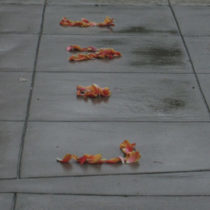Landscape Architecture for Landscape Architects › Forums › DETAILS & MATERIALS › Planting a 96″ Box Quercus agrifolia
- This topic has 1 reply, 5 voices, and was last updated 12 years, 3 months ago by
 toby.
toby.
-
AuthorPosts
-
April 15, 2013 at 12:09 am #155189
 jennifer BlochParticipant
jennifer BlochParticipantHello People,
Does anyone have any words of wisdom to share or any resources to help guide me in the process of planting a 96″ box specimen Oak?
Thanks – Jennifer
April 15, 2013 at 3:14 am #155201 tobyParticipant
tobyParticipantjust a few questions…what kind of oak? is it a container grown tree or is it from removed from the ground? how long in the box? is it going in on fill? on cut? what kind of soil? what existed exactly where this tree is going?
is it for yourself? for a client? who found it? who purchases? who’s responsible when it dies? will access be available to install another if this one dies?
have you considered hiring an independent party to look for any and all of the nasty bugs that attack oaks – both in the box tree and the location it’s going?
some installers are way way better than others. what’s the history of your’s?
April 15, 2013 at 4:28 am #155200 jennifer BlochParticipant
jennifer BlochParticipantthanks Toby.
It is a Quercus agrifolia. Field grown and then put in a container – or box. The actual tree hasn’t been selected yet so I have no idea how long it has been in the box or will have been…
It is for a client. The contractor is purchasing it. I am providing construction detail for installation. I am not responsible if it dies. I will make a note of that in my specs. (Thanks) I have a source for the tree but the contractor is allowed to find his own source as long as I approve it and can view the tree prior. There is a project arborist involved. The tree is going into a site among other oaks, mature Quercus lobata and Quercus alba exist in the planting area already. The arborist will oversee the installation and perhaps the tree selection process too.
The General Contractor is responsible for the bidding process for the Landscape Installer – I have no to little say in this selection – but I will mention to my client that this should be a question for the prospective installer.
What do you think?
Thanks!
The project is in Ross, Marin County.
April 15, 2013 at 11:07 am #155199 Andrew Garulay, RLAParticipant
Andrew Garulay, RLAParticipantAre you saying that you have to provide the methodology for how the tree is to be installed, or just a planting detail? The detail would be very similar to a container grown or b&b planting detail with the added note to remove the grate. My opinion is that if you supply the methodology, you are taking on the liability of the installation. I would leave the contractor to his own expertise (and responsibility) on how he is to accomplish how the tree gets from where ever it is coming from to the point where it matches the planting detail that you provide.
April 15, 2013 at 3:15 pm #155198 Jordan LockmanParticipantApril 15, 2013 at 3:21 pm #155197
Jordan LockmanParticipantApril 15, 2013 at 3:21 pm #155197 jennifer BlochParticipant
jennifer BlochParticipantI think you read this incorrectly Jordan. I am taking no liability. The thing is a client can come after me regardless so I am making a note that I am not responsible in the specs. In any case – my initial question had nothing to do with liability – and is chiefly concerning any specifics to insure that the tree is planted well. thanks – Jennifer
April 15, 2013 at 3:24 pm #155196 jennifer BlochParticipant
jennifer BlochParticipantI am not needing “methodology”. I am inquiring about planting detail. I have never planted a tree so large and am not sure how to anchor it – am thinking tree staples but? It will be planted in the Fall, and I’m specifying drip irrigation – but still should I call out that it is to be watered/soaked immediately upon planting? This is what I would normally do with a tree but it is an Oak and so it is a different animal… Thanks Andrew.
JB, MLA RLA
April 15, 2013 at 4:40 pm #155195 tobyParticipant
tobyParticipantSounds okay so far. Really, you’re asking about a transplant, not a container grown tree. How big is this tree going to be ? DBH, height, etc? Is the tree from nearby ?
Securing the tree is really dependent on the height of the tree. If the tree is field grown, then it probably won’t need any vertical support to encourage vertical growth and prevent leaning unless the rootball collapses on one side. Is your question about staples for this 8′ transplanted tree ? Despite what I wrote in the other thread, guy wires might be the best in this case if they are anchored outside of the pit.
As for watering, this is tricky to answer. Q ags will grow well with irrigation IF they have been irrigated their entire life. If it is naturally irrigated – rain, runoff, ground – and you add irrigation, it probably won’t do well. Has anybody potholed the soil where this tree is going. The natural moisture in the soil at 4′ deep will help determine how much irrigation the tree will need – temporary or permanent.
How impatient is your client (i.e., they have money and are desperate to burn it) or is this big tree some kind of settlement to get the project through the planners ? I ask because a smaller sized, nicely shaped, always irrigated oak would probably out grow something bigger that suffered significant root pruning in 10 years. Two irrigated Q ags in my yard are 45′ from acorns in 2001.
If it was me, I put the responsibility of the details and specs for the tree to whomever is digging, moving, and planting it, including how much irrigation it should need. Big trees are not the same as a 24 or 36 inch box tree.
edit — this is a harsh way to ask, but why are you providing details (other than ‘here’s what you should be asking’) for something that you barely have control over ?
April 15, 2013 at 5:43 pm #155194 jennifer BlochParticipant
jennifer BlochParticipantThanks Toby.
Tree Staples query was for this tree and others on this project. This is for a ground up residence and the architect/team member called for a specimen Oak to be planted in an area where there are already Oaks – aesthetically and plant community-wise it makes sense to me so I’m on board. But irrigated continuously it cannot be because of the existing oaks and oak understory planting. Per the water use Ordinance and arborist’s tree protection plan, water is to be cut after establishment in this area. The soil has been potholed. Thanks – I will lay the tree planted detail on the installer instead of drawing one – good idea. Thanks so very very much.
April 17, 2013 at 6:26 pm #155193 Jordan LockmanParticipant
Jordan LockmanParticipantThanks sorry must have been distracted..
April 19, 2013 at 1:47 am #155192 Darren AndreParticipant
Darren AndreParticipantHello Jennifer, Three years ago on one of our projects we planted 2-120″ box Q- agrifolias 1-84″ quercus agrifolia 1-72″ box and about 15-20 60″ box trees. (all are thriving) The 120″ and 84″ were field grown the 72″& 60″ were box grown. Because this project underwent quite a bit of grading and recompaction we made sure all of the trees had subdrains. 4″ diameter perforated pipe with sweep ells in 1′ of 3/4″ crushed rock. (Or 4″ perforated drain with filter sock and coarse sand backfill.) Fortunately the site has quite a bit of fall so we were able to get these subdrains to daylight to our v gutter system. This drain is set below the bottom of the rootball. (in a 1′ trench at the bottom of the pit.) We also try to dig the pit so water would drain to this trench.) This prevents excessive water from collecting in the bottom of the planting pit after irrigation. (Which can be like a bathtub if the soil is compacted to 95% Proctor.) The other thing we do is limit any organic amendments to the top 18″ of soil. (Everything below that is just site soil.) This prevents organic matter from putrefying under anaerobic conditions at the bottom the planting pit. (which could cause root rot) Fortunately we had a Sandy loam type site soil. Because the root ball was so large on the 120’s (and the trees fairly broad) we did not guy the trees in any way. But if i were to do so i might cable it to some sort of concrete deadman in the bottom of the pit to prevent it from overturning. (some people use pressure treated 6×6 timbers but i would go with something that wouldnt rot and isn’t impregnated with copper / chemicals. Its a good idea to have the arborist go out and look at the tree before delivery. (It may have rooted into the ground and could shock when when they they move it to the truck.)(typically symptoms probably wouldnt show up for a couple weeks) We use a very good tree broker who is good at identifying such problems. BTW They are usually very resilient trees! Hope that helps!?
April 19, 2013 at 1:50 am #155191 jennifer BlochParticipant
jennifer BlochParticipantDarren,
Thank You.
JB
April 20, 2013 at 9:09 pm #155190 jennifer BlochParticipant
jennifer BlochParticipantThanks Scott. JB
-
AuthorPosts
- You must be logged in to reply to this topic.


